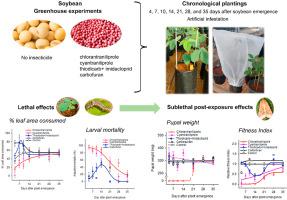Crop Protection ( IF 2.5 ) Pub Date : 2023-03-01 , DOI: 10.1016/j.cropro.2023.106214 Paula G. Páez Jerez , Antonio C.L. Alves , Johana E. Quinteros Cortes , Leidiana M. Ribeiro , Jorge G. Hill , M. Teresa Vera , Mateus P. Gonzatto , Rafael M. Pitta , Eliseu J.G. Pereira

|
In intensive soybean cropping systems, early-season pest insects such as lepidopteran larvae can seriously compromise crop establishment. Using a polyphagous global pest the Old World bollworm Helicoverpa armigera (Lepidoptera: Noctuidae), we determined the potential of seed treatments with diamide or neonicotinoid-carbamate mixture for systemic plant protection and residual efficacy against noctuid larvae. In controlled edaphoclimatic conditions, we infested differently aged soybean plants and recorded plant damage and insect mortality, growth, development, and fecundity to assess lethal and sublethal post-exposure effects. The seed treatments reduced plant damage by 50% during 1–7 days after plant emergence. The lowest damage (<25% defoliation) occurred on plants treated with chlorantraniliprole or cyantraniliprole. These diamides caused larval mortality >80% until 14 days after soybean emergence, which was the window of residual control efficacy. Carbofuran or thiodicarb + imidacloprid caused less than 50% larval mortality and minor plant protection against the larvae. There were sublethal effects on the growth, development, and fecundity of the insects surviving on plants of the insecticide seed treatments. The diamide seed treatments reduced the overall insect fitness for a longer time after plant emergence than did the other treatments. Therefore, soybean seed treatment with chlorantraniliprole or cyantraniliprole is potentially efficacious against noctuid larvae in the VE–V1 soybean growth stages (emergence until the first trifoliate), causing lethal and sublethal effects on the insects. Judicious use and effective resistance management for these systemic compounds are relevant as they are helpful for seed treatment and foliar applications against diverse targets.
中文翻译:

Diamide 种子处理可以保护早期大豆生长阶段免受棉铃虫的侵害
在集约化的大豆种植系统中,鳞翅目幼虫等早季害虫会严重危害作物的生长。使用多食性全球害虫旧大陆棉铃虫棉铃虫(鳞翅目:夜蛾科),我们确定了用二酰胺或新烟碱-氨基甲酸酯混合物进行种子处理的潜力,用于系统性植物保护和对夜蛾幼虫的残留功效。在受控的土壤气候条件下,我们侵染不同年龄的大豆植物并记录植物损害和昆虫死亡率、生长、发育和繁殖力,以评估致死和亚致死后暴露效应。在植物出苗后的 1-7 天内,种子处理将植物损害减少了 50%。最低的损害(<25% 落叶)发生在用氯虫苯甲酰胺或溴氰虫酰胺处理的植物上。这些二胺导致大豆幼虫死亡率 >80%,直到大豆出苗后 14 天,这是残留控制效果的窗口。克百威或硫双威 + 吡虫啉导致低于 50% 的幼虫死亡率和对幼虫的轻微植物保护。对在杀虫剂种子处理的植物上存活的昆虫的生长、发育和繁殖力有亚致死作用。与其他处理相比,二酰胺种子处理在植物出苗后降低整体昆虫适应性的时间更长。因此,用氯虫苯甲酰胺或溴氰虫酰胺处理大豆种子可能对 VE-V1 大豆生长阶段(出现直到第一三叶)的夜蛾幼虫有效,对昆虫造成致死和亚致死影响。这些内吸化合物的明智使用和有效的抗性管理是相关的,因为它们有助于针对不同目标的种子处理和叶面施用。对在杀虫剂种子处理的植物上存活的昆虫的生长、发育和繁殖力有亚致死作用。与其他处理相比,二酰胺种子处理在植物出苗后降低整体昆虫适应性的时间更长。因此,用氯虫苯甲酰胺或溴氰虫酰胺处理大豆种子可能对 VE-V1 大豆生长阶段(出现直到第一三叶)的夜蛾幼虫有效,对昆虫造成致死和亚致死影响。这些内吸化合物的明智使用和有效的抗性管理是相关的,因为它们有助于针对不同目标的种子处理和叶面施用。对在杀虫剂种子处理的植物上存活的昆虫的生长、发育和繁殖力有亚致死作用。与其他处理相比,二酰胺种子处理在植物出苗后降低整体昆虫适应性的时间更长。因此,用氯虫苯甲酰胺或溴氰虫酰胺处理大豆种子可能对 VE-V1 大豆生长阶段(出现直到第一三叶)的夜蛾幼虫有效,对昆虫造成致死和亚致死影响。这些内吸化合物的明智使用和有效的抗性管理是相关的,因为它们有助于针对不同目标的种子处理和叶面施用。与其他处理相比,二酰胺种子处理在植物出苗后降低整体昆虫适应性的时间更长。因此,用氯虫苯甲酰胺或溴氰虫酰胺处理大豆种子可能对 VE-V1 大豆生长阶段(出现直到第一三叶)的夜蛾幼虫有效,对昆虫造成致死和亚致死影响。这些内吸化合物的明智使用和有效的抗性管理是相关的,因为它们有助于针对不同目标的种子处理和叶面施用。与其他处理相比,二酰胺种子处理在植物出苗后降低整体昆虫适应性的时间更长。因此,用氯虫苯甲酰胺或溴氰虫酰胺处理大豆种子可能对 VE-V1 大豆生长阶段(出现直到第一三叶)的夜蛾幼虫有效,对昆虫造成致死和亚致死影响。这些内吸化合物的明智使用和有效的抗性管理是相关的,因为它们有助于针对不同目标的种子处理和叶面施用。用氯虫苯甲酰胺或氰虫苯甲酰胺处理大豆种子可能对 VE-V1 大豆生长阶段(出现直到第一个三叶)的夜蛾幼虫有效,对昆虫造成致死和亚致死影响。这些内吸化合物的明智使用和有效的抗性管理是相关的,因为它们有助于针对不同目标的种子处理和叶面施用。用氯虫苯甲酰胺或氰虫苯甲酰胺处理大豆种子可能对 VE-V1 大豆生长阶段(出现直到第一个三叶)的夜蛾幼虫有效,对昆虫造成致死和亚致死影响。这些内吸化合物的明智使用和有效的抗性管理是相关的,因为它们有助于针对不同目标的种子处理和叶面施用。










































 京公网安备 11010802027423号
京公网安备 11010802027423号